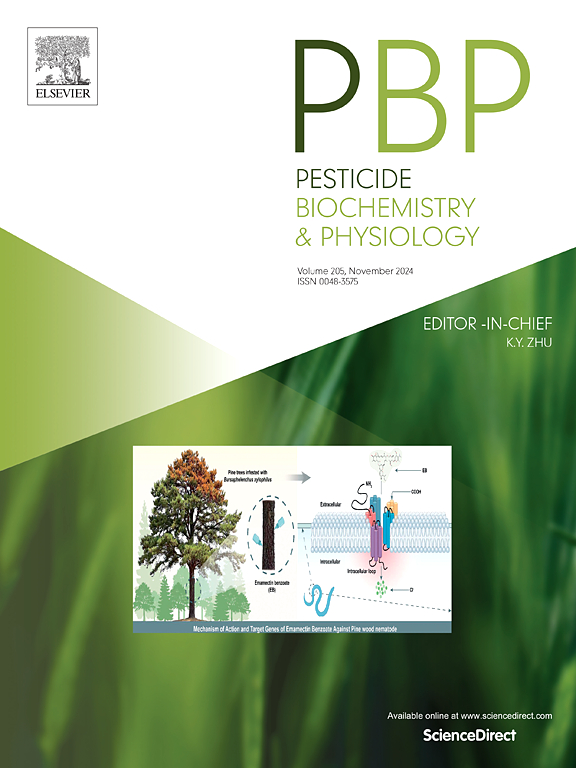脂质表面微滴2 (LSD2)调控成虫脂质代谢和雄性生殖生理
IF 4.2
1区 农林科学
Q2 BIOCHEMISTRY & MOLECULAR BIOLOGY
引用次数: 0
摘要
昆虫代谢在形成生殖生理方面起着至关重要的作用,为害虫管理策略和生态理解提供了有价值的见解。在本研究中,我们研究了脂质表面液滴蛋白LSD2的调控及其对谷类小麦脂质代谢和雄性生殖事件的影响。使用ScLSD2 RNAi,我们评估了它对谷类小麦成虫能量代谢、精子数量、活力、产卵和孵化率的影响。我们的研究结果揭示了ScLSD2的组织特异性表达,主要在脂肪体中。沉默ScLSD2导致交配率、精子运动参数、产卵和孵化率降低,同时能量代谢物发生改变,包括脂滴、甘油三酯和甘油水平降低,二甘油三酯含量增加。此外,精子定量显示,在ScLSD2沉默后,真核精子数量显著减少,表明生殖功能受损。这些结果表明,LSD2在连接谷类小麦的脂质代谢和生殖生理方面起着关键作用,将其定位为害虫管理策略的一个有希望的目标。本文章由计算机程序翻译,如有差异,请以英文原文为准。

Lipid surface droplet 2 (LSD2) regulates lipid metabolism and male reproductive physiology in adult Sitotroga cerealella
Insect metabolism plays a critical role in shaping reproductive physiology, offering valuable insight for pest management strategies and ecological understanding. In this study, we investigated the regulation of the lipid surface droplet protein LSD2 and its impact on lipid metabolism and male reproductive events in Sitotroga cerealella. Using ScLSD2 RNAi, we assessed it effects on energy metabolism, sperm count, motility, oviposition, and hatchability in S. cerealella adults. Our results reveal tissue-specific expression of ScLSD2, predominantly in the fat body. Silencing ScLSD2 led to reduced mating rates, sperm motility parameters, oviposition, and hatchability, alongside alteration in energy metabolites, including decreased in lipid droplets, triglyceride and glycerol levels and increased diglyceride content. Additionally, sperm quantification revealed significant reductions in eupyrene sperm count following ScLSD2 silencing, indicating impaired reproductive function. These results show the pivotal role of LSD2 in linking lipid metabolism and reproductive physiology in S. cerealella, positioning it as a promising target for pest management strategies.
求助全文
通过发布文献求助,成功后即可免费获取论文全文。
去求助
来源期刊
CiteScore
7.00
自引率
8.50%
发文量
238
审稿时长
4.2 months
期刊介绍:
Pesticide Biochemistry and Physiology publishes original scientific articles pertaining to the mode of action of plant protection agents such as insecticides, fungicides, herbicides, and similar compounds, including nonlethal pest control agents, biosynthesis of pheromones, hormones, and plant resistance agents. Manuscripts may include a biochemical, physiological, or molecular study for an understanding of comparative toxicology or selective toxicity of both target and nontarget organisms. Particular interest will be given to studies on the molecular biology of pest control, toxicology, and pesticide resistance.
Research Areas Emphasized Include the Biochemistry and Physiology of:
• Comparative toxicity
• Mode of action
• Pathophysiology
• Plant growth regulators
• Resistance
• Other effects of pesticides on both parasites and hosts.

 求助内容:
求助内容: 应助结果提醒方式:
应助结果提醒方式:


